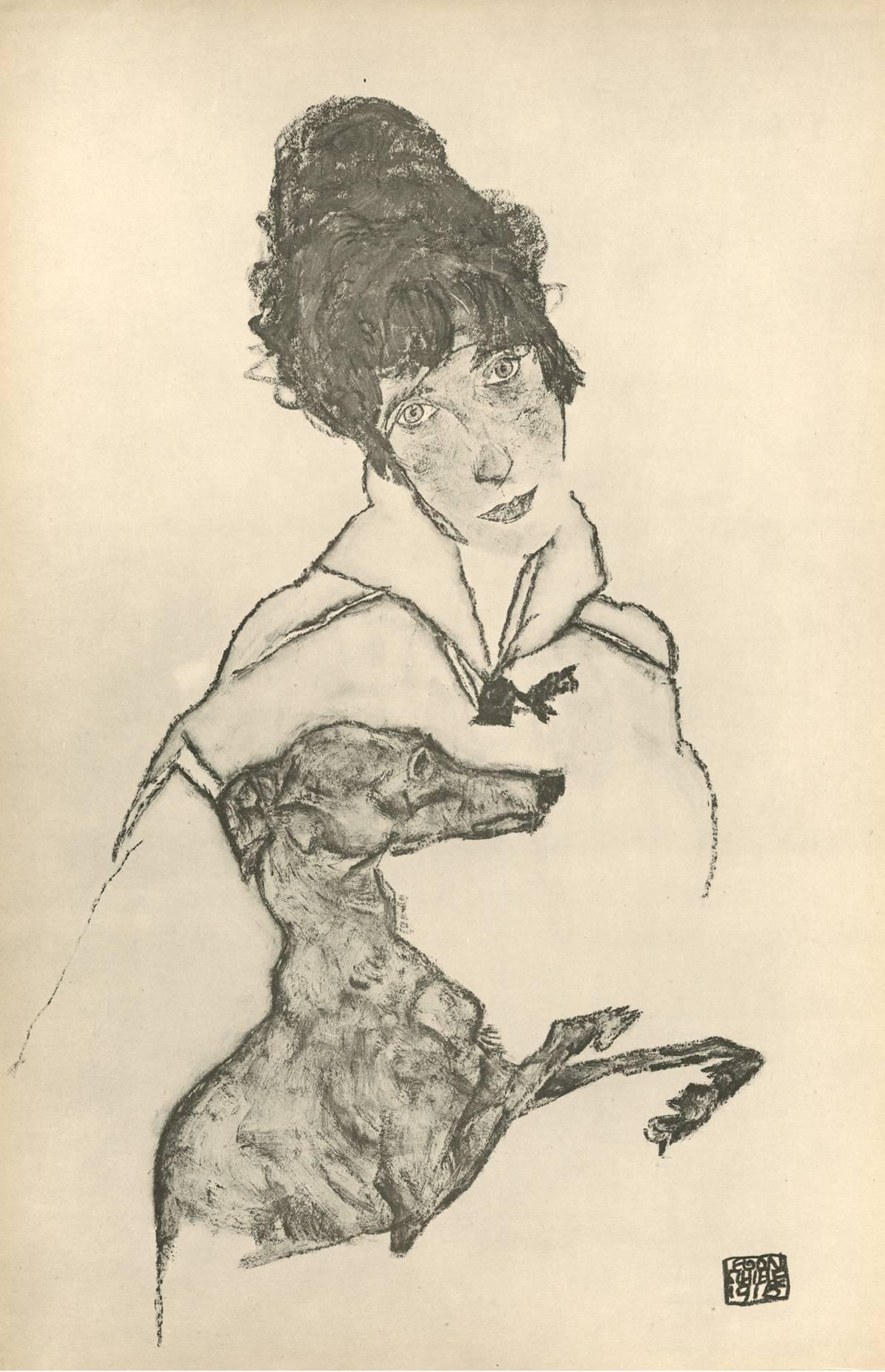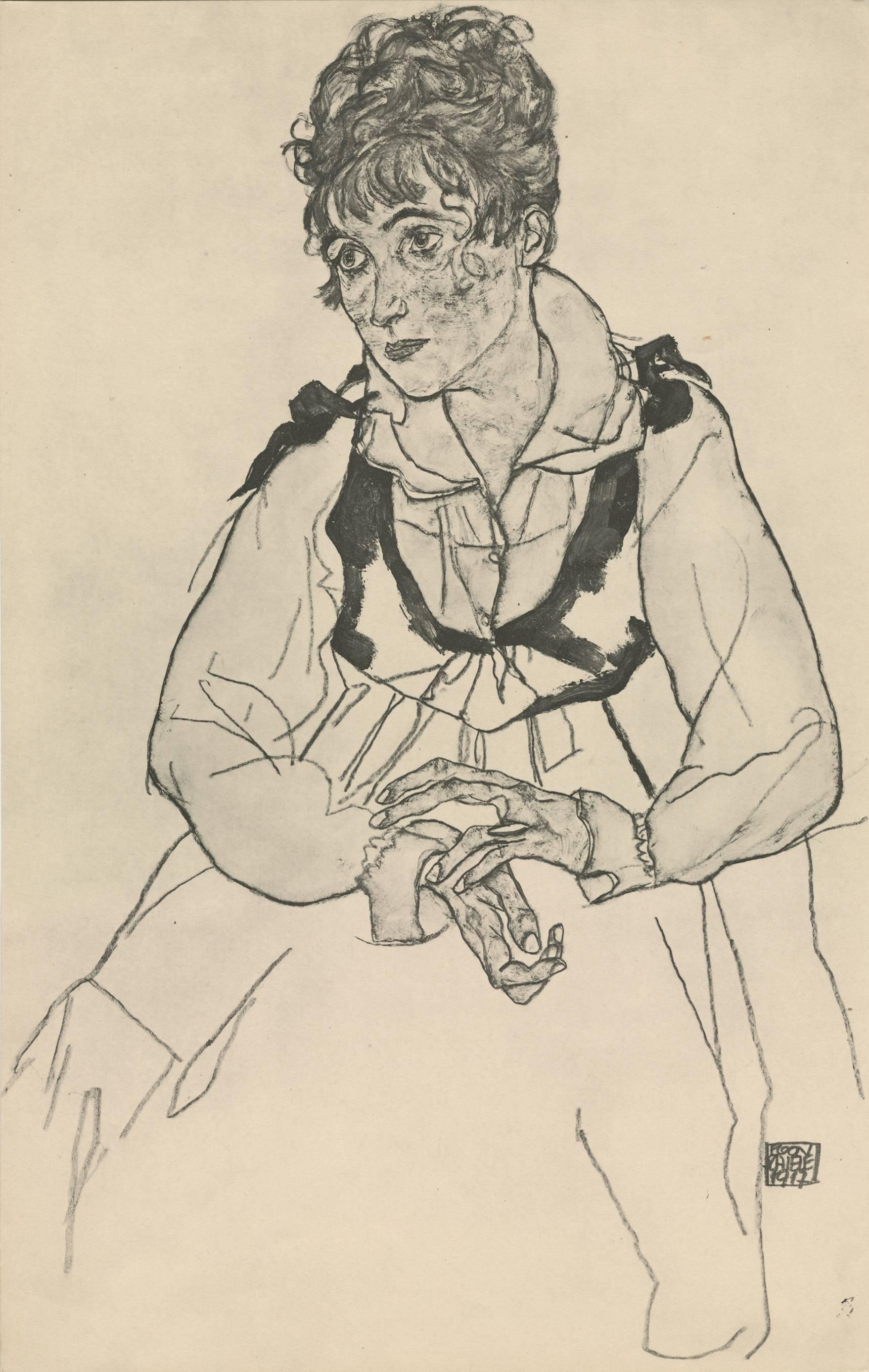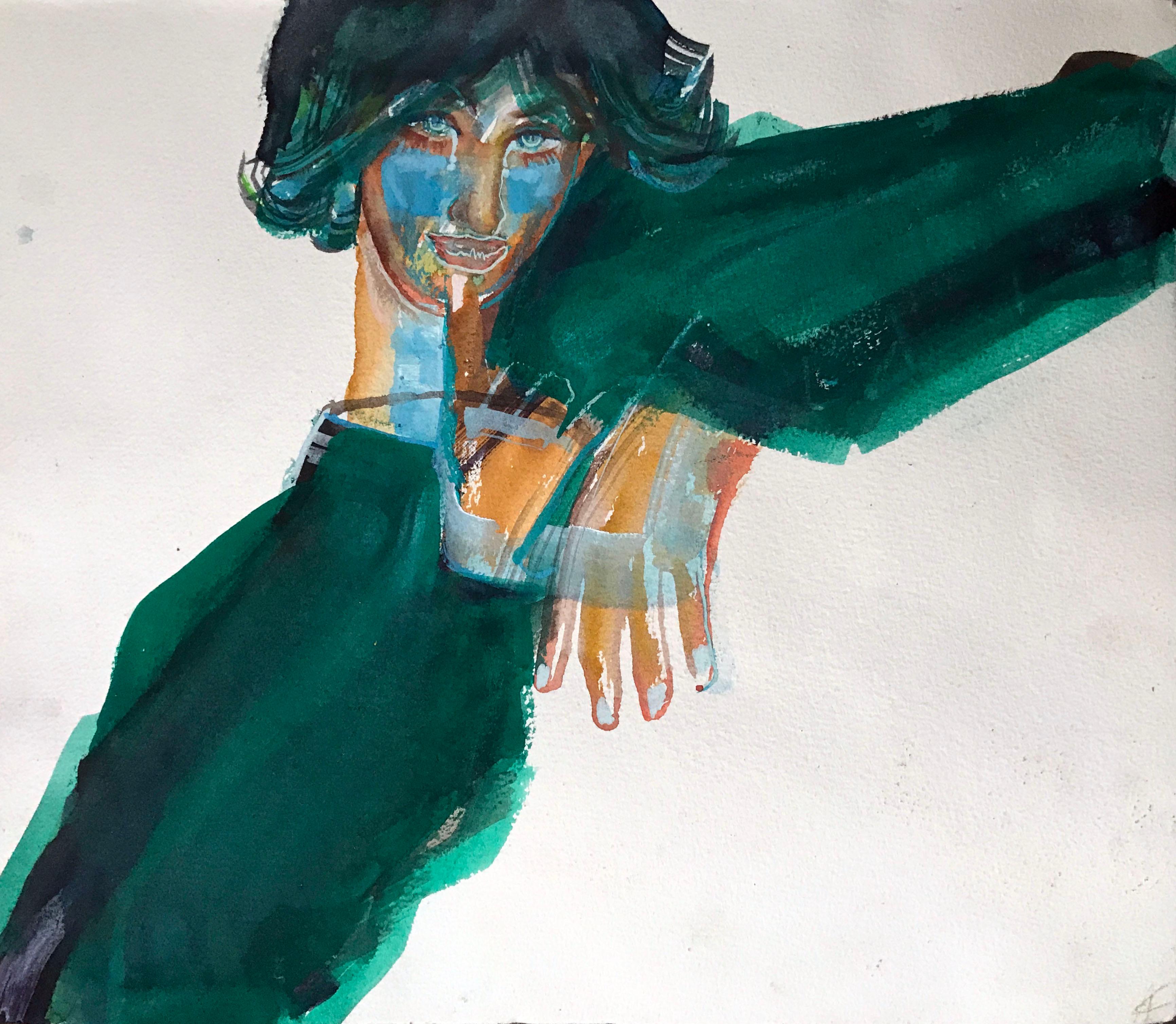Items Similar to E. Strache, Handzeichnungen folio, "Self-Portrait" Collotype plate
Want more images or videos?
Request additional images or videos from the seller
1 of 6
(after) Egon SchieleE. Strache, Handzeichnungen folio, "Self-Portrait" Collotype plate1920
1920
About the Item
after Egon Schiele (1890 – 1918), AUSTRIA
“ART CANNOT BE MODERN, ART IS PRIMORDIALLY ETERNAL.” -SCHIELE
Defiantly iconoclastic in life and art, Egon Schiele is esteemed for his masterful draftsmanship and precocious insight into the human condition. Part of the first wave of Austrian Modernism, he was swept away by the Viennese fascination with the tension between Life and Death (known in the works of Freud and his later interpreters as Eros and Thanatos). Life, identified with attraction, love, sexuality, and reproduction, and Death, represented by distortion, disease, repulsion, and hysteria, often appeared in the same composition, thereby suggesting the frightening life cycle of the human mind and body.
Young throughout his career, Schiele universalized his childhood traumas, thriving libido, insecurities, fears, and longings. His contorted line, jarring contrasts, and flat areas of color, demonstrate an early alliance with Expressionist philosophy and artists who were relentlessly frustrated by conventionality in all its forms. Schiele’s work embodied man’s disorientation and confusion in a seemingly absurd world, a world plagued by disease and war. It continues to be astonishingly relevant today, not just because it helped define Modernism but also because it revealed the dark and immutable aspects of the human condition.
Handzeichnungen, is a fine art portfolio consisting of 15 collotype prints after original watercolors and drawings by Egon Schiele, four of which are in color. Published by Verlag Eduard Strache, Vienna, Prague, Leipzig, 1920, in an edition of 510: the first group numbered I - X were hand signed by Schiele and included an original drawing by Schiele. The art images were printed by Kunstanstalt Max Jaffe, Vienna; the portfolio with printed written pages was printed by Gesellschaft fur Graphische Industrie, Wien VI.
Although Egon Schiele’s Handzeichnungen portfolio was published posthumously in 1920, there is evidence that on the heels of his highly successful sold-out run number-ing 400 copies with his 1917 portfolio of monochromatic prints entitled Zeichnungen, Schiele was already planning a bigger and more elaborate follow-up upon his untimely death in 1918. The final print in Handzeichnungen features a stunning color print of a Kneeling Female (semi-nude) from the collection of Kunsthandlung Richard Lanyi. This same image was the seventh featured in Schiele’s Zeichnungen portfolio from 1917 published by Richard Lanyi. Clearly, Schiele’s first publisher approved of Handzeichnungen’s publication as he contributed one of the featured works. He also saw the opportunity to showcase Schiele’s work from what had been an entirely mono-chromatic collection of prints to an even more highly sophisticated portfolio including color collotype print work. A copy surely was to be found in his gallery/salon, a hot-bed of intelligentsia activity.
Posthumous printed portfolios such as Handzeichnungen are a continuation of the tradition Gustav Klimt and Egon Schiele helped to develop and popularize in Vienna during their lifetimes. Schiele's hand joined so many ways of seeing to capture the erotic, the intellectual, the esthetic. In the early years of 20th century Vienna, there was no clear separation between fine art, science, sociology and politics or philosophy; the cross-pollinating character of Viennese intellectual life was robust. Rather than cut-off and confined to the university, intellectual activity thrived in social spheres such as coffee houses and salons. Huge overlap existed among these inter-disciplinary circles. In a city numbering approximately 2 million, only a few hundred comprised the cultural and political elite. Schiele exhibited widely, helped to organize exhibitions and had earned such a following that upon the death of Gustav Klimt in February the year following Zeichnungen’s publication, Schiele had naturally taken up the torch as Klimt’s successor. As leader of the 49th Vienna Secession Exhibition in 1918, the responsibility to create an exhibition poster and art for the main gallery fell on Schiele’s shoulders. Critical accolades for his Expressionist work made certain Schiele’s leading position in the world of art. Shiele’s posthumously published portfolio is, no doubt, an art piece as well as a key into the intellectual circles which characterized early-20th century Vienna. Schiele’s portfolios were the very picture of Viennese life: they were collaborations between a fine artist; art collectors; art promotors; idea disseminators; scientists; and printers.
The collotype print form was at this time the preferred method of reproducing fine works of art. The printer of Schiele’s Zeichnungen and Handzeichnungen portfolios was Max Jaffe, a Viennese specialist in fine art collotypes. This dichromate-based photographic process had been invented in 1856 and predates lithography. The gelatin plates required delicate preparation involving light exposure, washing, and curing. They were inked with a velvet or leather roller and printed using a hand proof process with a light-pressured press. Collotype plates could not be re-used; the limited edition prints made from colloid inks were stable and posed no danger of fading like other photographic processes of the time. In fact, the fine reticulations created on the plates using the collotype process produced prints of extremely high quality. Lithography later replaced the collotype process which has now become nearly a lost art.
- Creator:(after) Egon Schiele (1890 - 1918, Austrian)
- Creation Year:1920
- Dimensions:Height: 18.75 in (47.63 cm)Width: 11.5 in (29.21 cm)
- Medium:
- Movement & Style:
- Period:
- Condition:Literature: see "Egon Schiele: The Complete Works" by Jane Kallir. 1990. Pg. 514 (#1433).
- Gallery Location:Chicago, IL
- Reference Number:1stDibs: LU46736447362

About the Seller
5.0
Gold Seller
These expertly vetted sellers are highly rated and consistently exceed customer expectations.
Established in 2013
1stDibs seller since 2016
84 sales on 1stDibs
Typical response time: 1 hour
- ShippingRetrieving quote...Ships From: Chicago, IL
- Return PolicyA return for this item may be initiated within 3 days of delivery.
More From This SellerView All
- R. Layni, Zeichnungen folio, "One-Year-Volunteer Private" Collotype plate VLocated in Chicago, ILEgon Schiele (1890 – 1918), AUSTRIA “ART CANNOT BE MODERN, ART IS PRIMORDIALLY ETERNAL.” -SCHIELE Defiantly iconoclastic in life and art, Egon Schiele is esteemed for his masterful...Category
1910s Vienna Secession Portrait Prints
MaterialsPaper
- R. Layni, Zeichnungen folio, "Woman with Greyhound" Collotype plate IIILocated in Chicago, ILEgon Schiele (1890 – 1918), AUSTRIA “ART CANNOT BE MODERN, ART IS PRIMORDIALLY ETERNAL.” -SCHIELE Defiantly iconoclastic in life and art, Egon Schiele is esteemed for his masterful...Category
1910s Vienna Secession Portrait Prints
MaterialsPaper
- R. Layni, Zeichnungen folio, "The Artist's Wife, Seated" Collotype plate VILocated in Chicago, ILEgon Schiele (1890 – 1918), AUSTRIA “ART CANNOT BE MODERN, ART IS PRIMORDIALLY ETERNAL.” -SCHIELE Defiantly iconoclastic in life and art, Egon Schiele is esteemed for his masterfu...Category
1910s Vienna Secession Portrait Prints
MaterialsPaper
- E. Strache, Handzeichnungen folio, "Portrait Study (Head of a Girl)" CollotypeBy (after) Egon SchieleLocated in Chicago, ILafter Egon Schiele (1890 – 1918), AUSTRIA “ART CANNOT BE MODERN, ART IS PRIMORDIALLY ETERNAL.” -SCHIELE Defiantly iconoclastic in life and art, Egon Schiele is esteemed for his mas...Category
1920s Vienna Secession Portrait Prints
MaterialsPaper
- H.O. Miethke Das Werk folio "The Kiss" collotype printBy Gustav Klimt & K.K. Hof-und StaatsdruckereiLocated in Chicago, ILThe Kiss, no. 1 from the fifth installment of Das Werk Gustav Klimts Undoubtedly Klimt’s best known and most reproduced images, this printed version of The Kiss is the only one with which Klimt was directly involved. Unveiled at Vienna’s Kunstschau 1908, and saved for the fifth and final delivery of Das Werk, The Kiss marks a triumph in Klimt’s career and represents a culmination of many themes in his oeuvre up to that point. After all of the controversy surrounding the State’s prior rejection of the University murals commissioned from Klimt, the Ministry of Education reversed their policy toward the artist with a show of wholehearted support by purchasing for the Osterreichische Galerie BelvedereThe Kiss while it still hung in the Kunstschau exhibit. Considered in relation to the eight multicolored collotypes which preceded its print debut in the Das Werk portfolio, The Kiss literally embraces all which came before it. The golden seaweed dangling in tresses from the lovers’ feet harkens back to Water Snakes I and II. The bed of flowers evokes the settings Klimt created in both The Golden Knight and The Sunflower. In fact, this image sprung out of a particularly happy summer spent in the company of Klimt’s lover, Emilie Floge...Category
Early 1900s Vienna Secession Figurative Prints
MaterialsHandmade Paper
- H.O. Miethke Das Werk folio "Portrait of Helene Klimt" collotype printBy Gustav Klimt & K.K. Hof-und StaatsdruckereiLocated in Chicago, ILDAS WERK GUSTAV KLIMTS, a portfolio of 50 prints, ten of which are multicolor collotypes on chine colle paper laid down on hand-made heavy cream wove paper with deckled edges; under ...Category
Early 1900s Vienna Secession Figurative Prints
MaterialsPaper
You May Also Like
- Original Vintage Secession Poster celebrating the emperor's jubileeLocated in Zurich, CHOriginal Vintage Poster by the Austrian artist Ferdinand Ludwig Graf, a member of the Hagenbund. This Viennese artist association moved as soon a...Category
Early 1900s Vienna Secession Figurative Prints
MaterialsPaper
- Emerald boyBy Anastasia KurakinaLocated in London, GBportrait of a boy Limited edition Hand signedCategory
2010s Vienna Secession Prints and Multiples
MaterialsPaper, C Print, Color, Digital
- NANETTEBy Nicola SimbariLocated in Aventura, FLSerigraph on paper. Hand signed and numbered by the artist. Artwork appears to be in excellent condition. Artwork has not been examined outside the matting. Image size: 27 x 39 in. M...Category
1970s Expressionist Portrait Prints
MaterialsScreen, Paper
- Portrait of a WomanBy Nic JonkLocated in Soquel, CAVibrant portrait of a woman in a blue hat with bright, bold colors by Nic Jonk (Dutch, 1928-1994). Print from the artist's Gallery & Sculpture Garden in Grootschermer, Holland. Displ...Category
1980s Expressionist Figurative Prints
MaterialsFoam Board, Ink, Paper
- Homage a Leonard de Vinci-Front. Self-portrait of de VinciBy Claude WeisbuchLocated in Milwaukee, WIThis is an original color lithograph created by Claude Weisbuch. It was designed to promote his show at Vision Nouvelle, a gallery in France. This show in particular was about his Ho...Category
1970s Expressionist Prints and Multiples
MaterialsLithograph, Paper
- Marc Chagall - Four Tales from the Arabian Nights - COMPLETE SET (12)By Marc ChagallLocated in Los Angeles, CAMarc Chagall (1887-1985) FOUR TALES FROM THE ARABIAN NIGHTS (MOURLOT 36 - 47; CRAMER BOOKS 18) The complete set of twelve lithographs printed in co...Category
Mid-19th Century Expressionist Figurative Prints
MaterialsLithograph, Laid Paper
Recently Viewed
View AllMore Ways To Browse
Fur Plates
Cut To Clear Plates
Portrait On Leather
Early 20th Century Female Portraits
Antique Hot Plate
Original Cycling Posters
Used Leather Portfolio
Coffee Jar
Semi Nude Female
Antique Leather Bed
Antique Cycling Posters
Poster Bed Used
Folio Leather
Erotic Poster
Antique Poster Beds
Vienna Secession Art Posters
Washing Line
Prague Poster





